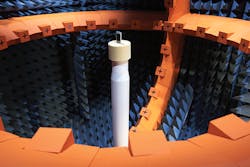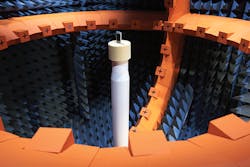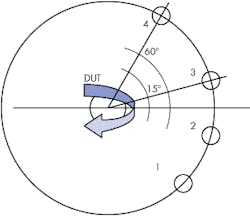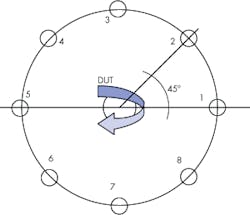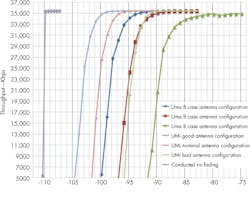Multiple input multiple output (MIMO) devices make 4G performance possible through their ability to function in complex RF environments. Multiple antennas enable increased data throughput and quality of service without increasing transmission power or bandwidth. But these devices need testing systems capable of simulating various RF environments in a repeatable and controlled manner in order to find the right antenna configuration.
There are several methods currently being evaluated to simulate these RF environments. As a representative of these methods, SATIMO’s StarMIMO MIMO testing system will be evaluated. StarMIMO (Fig. 1) is based on the spatial fading emulation technique. It relies on the use of a spatial fading emulator and a number N of transmitting probes located in an array around the device under test or on a sector of the array itself.
This technique enables users to properly emulate the standardized channel models such as SCME UMi (Spatial Channel Model Extended Urban Micro), and UMa (Urban Macro) at the device-under-test (DUT) location. The goal is to understand whether the proposed MIMO OTA methodology is suitable for discriminating between good and bad MIMO antenna systems in terms of the absolute data throughput performances.
Presented is the channel model validation results along with the throughput versus power results of the same DUT when using different antenna systems, with measurement in the LTE BAND 13 (751MHz) where the good, nominal, and bad antenna systems are available. With a baseline established, we can gain deeper insight on how to maximize MIMO antenna performance in a wide range of real-world environments.
MIMO devices are delivering consumers better bandwidth and quality of service. But their development creates a whole new set of challenges for proper and accurate antenna testing environments. MIMO uses multipath propagation to improve data throughput, therefore a configurable RF environment is needed to reliably test antenna performance. A successful simulator to test MIMO devices must emulate an entire spectrum of RF environments in a repeatable and controlled manner.
In order to understand the end-to-end reception performance of a MIMO device, over-the-air (OTA) testing is needed. This is primarily due to the fact that correlation plays an important role in multiple-antenna systems. The level of correlation cannot be determined based on the antenna characteristics alone without knowing the propagation characteristics. When testing devices with multiple antennas, it is therefore necessary to include both the antenna and propagation characteristics in the setup, thus the need of a new OTA testing methodology.
This file type includes high resolution graphics and schematics when applicable.
The SISO OTA measurements setup is no longer suitable for such testing, which relies on measuring the 3D power or received sensitivity pattern measurements with an isotropic weighting, uniform channel model. Therefore, total radiated power (TRP) and TIS (total isotropic sensitivity (TIS) are no longer used as a standard figure of merit, since they are not taking into account the propagation model’s characteristics. Due to the complexity of multiple antenna setups, a flexible and accurate testing solution becomes a major asset in the antenna design cycle, final product verification—and most importantly, time-to-market for the device.
The wireless industry, through the CTIA and 3GPP standardization bodies, has been studying the anechoic-chamber-based OTA technique since 2009. In CTIA, a draft MIMO OTA test plan for this technique has been agreed upon. The goal is the inclusion of this test plan in the CTIA OTA test plan specification by early 2015.
The LTE MIMO anechoic chamber based OTA approach emulates complex spatial-temporal propagation environments at the device location in a realistic and repeatable way by using a radio channel emulator connected to a circular array of probes (multiple cluster) or an array of probes on one side of the chamber forming a single spatial cluster model. Either configuration is referred to as the multi-probe technique. This technique addresses the need to generate precise spatial channel models at the device location for the evaluation of MIMO antenna and handset performance.
Wideband cellular channels exhibit the cluster behavior which can be taken into account by emulating the spatial channel model within the anechoic chamber. The clusters are then simultaneously mapped to the probes so that the sum of the transmitted signals at the DUT location is as defined in the model. These measurement-based channel models include all dimensions of the radio channel (time, frequency, space, and polarization). Each cluster is split between several probes to enable angular spread. As a result, the geometry-based environment of the channel model is accurately reproduced within the anechoic chamber.
It must be noted that on such a measurement system, the signals are coming simultaneously from N (number of probes) directions around the DUT (device-under-test) as opposed to SISO, in which the signal is coming from one direction at a time. This characteristic combined with a spatial channel emulator, provide the ability to emulate a spatial-temporal propagation model at the DUT location.
The probes’ locations play an important role here. Probes can be located on a single sector (single cluster approach) or on a full circle (multiple cluster approach):
Single cluster (sector setup). Figure 2 shows a possible implementation of a single sector setup, utilizing a single cluster approach. Four dual polarized probes are located on a sector of the array.
Geometry based stochastic channel model (GSCM) can be then built and emulated at the DUT location. Complexity of the setup is then reduced by using this approach versus the full ring setup.
Multiple cluster (full ring setup). The next depiction is of a full ring, multiple cluster implementation. Eight dual polarized probes are located at 45 deg. distance on a full ring.
Once the channel models are defined and before starting any testing activity, the emulated channel models must be verified at the DUT location in order to address any impairments which will be added by the setup to the channel models. The verification will consist in measuring the following four main parameters which would characterize spatial-temporal channel models:
- PDP – power delay profile
- Doppler spectrum – temporal correlation
- Spatial correlation
- XPR – cross polarization ratio
The testing procedure is approved by both 3GPP and CTIA.
To test whether StarMIMO is a valid methodology for discriminating between Good and Bad antenna systems, the wireless industry through the CTIA and 3GPP standardization bodies agreed to develop a set of 2 X 2 MIMO reference antennas to validate each MIMO OTA methodology and understand whether the methodology is suitable in discriminating between Good and Bad antenna systems in terms of the absolute throughput performance of the UE (User Equipment—any wireless devices supporting 3G and 4G).
A 2 X 2 MIMO channel in downlink (reception) consists of two base station antenna (e-NodeB antennas) transmitting and two RX antenna placed on the UE. Based on this concept, a 2 X 2 MIMO reference antenna is an antenna system made by two antennas which can be used as a baseline for designing UE antenna systems. Since UE manufacturers typically do not disclose antenna performances, the MIMO 2 X 2 reference antenna concept provides insight into the performances of the LTE MIMO devices currently available on the market.
In an effort to compare the different methodologies to a baseline, the absolute data throughput framework was defined and used to compare each MIMO OTA testing method’s ability to emulate the specified propagation characteristics based on an absolute data throughput metric (Fig. 4).
As markets continue to be saturate with MIMO systems, it becomes ever more critical to speed up time-to-market on any product that has the ability to stand out from the competition. This need will continue to drive the search for the best testing approach that will ultimately help bring good products to market faster.
While there are many testing systems and methodologies still under evaluation, a method was shown that did prove itself effective in discriminating between Good and Bad MIMO antenna systems. It provides clear evidence that is validated by running absolute data throughput testing on the same reference device by using the same channel models.
This file type includes high resolution graphics and schematics when applicable.
